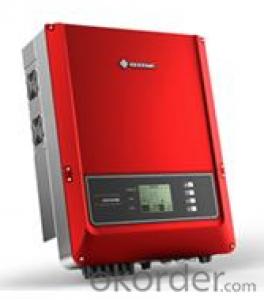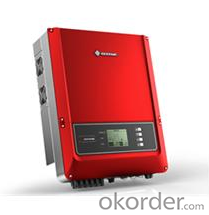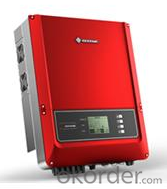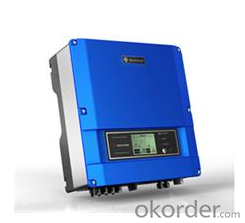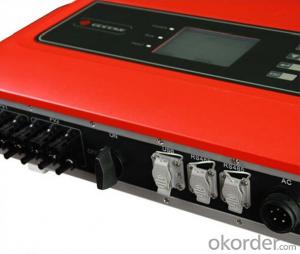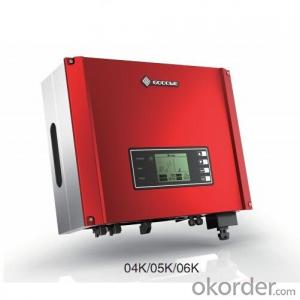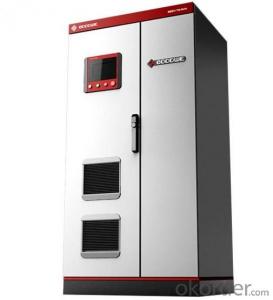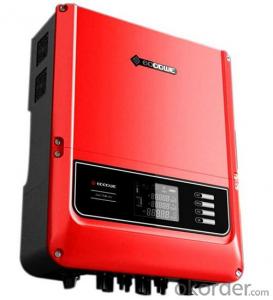5k Solar Inverter GW12K-DT On Grid Solar Inverter
- Loading Port:
- Shanghai
- Payment Terms:
- TT OR LC
- Min Order Qty:
- 10 unit
- Supply Capability:
- 100 unit/month
OKorder Service Pledge
Quality Product, Order Online Tracking, Timely Delivery
OKorder Financial Service
Credit Rating, Credit Services, Credit Purchasing
You Might Also Like
GW12K-DT
GW12K-DT photovoltaic inverter is suitable for commercial and industrial roofs as well as small and medium-sized photovoltaic power systems. Rich communication interfaces make it more convenient for network and monitoring. The use of film capacitor achieves longer service life, more stable system and super-large LCD screen so that we have a commanding view to the run data of the machine.
| DC Input Data | Max.PV-generator power[W] | 12300 |
| Max.DC voltage[V] | 1000 | |
| MPPT voltage range[V] | 500~800 | |
| Turn on DC voltage[V] | 250 | |
Max.DC work current[A] | 22/11 | |
| Number of inputs/MPP trackers | 4/2 | |
| DC connector | SUNCLIX,MC IV (optional) | |
| Standby power consumption [W] | 10 | |
| AC Output Data | Nominal AC power[W] | 12000 |
| Max.AC power[W] | 12000 | |
| Max.output current[A] | 19 | |
| Nominal output voltage range | VDE-AR-N4105,VDE0126-1-1/A1,RD1699,G59/2,AS4777.2/.3 | |
| AC grid frequency | VDE-AR-N4105,VDE0126-1-1/A1,RD1699,G59/2,AS4777.2/.3 | |
| THDi | <1.5%< td=""> | |
| Power factor | 0.90 leading...0.90 lagging | |
| AC connection | 3W/N/PE,230/400V | |
| Efficiency | Max.efficiency | 98.0% |
| European efficiency | 97.5% | |
| MPPT adaptation efficiency | >99.5% | |
| Safty Equipment | Leakage current monitoring unit | Integrated |
| DC switch disconnector | Optional | |
| Islanding protection | AFD | |
| Grid monitoring | VDE-AR-N4105,VDE0126-1-1/A1,RD1699,G59/2,AS4777.2/.3 | |
| Normative Reference | EMC compliance | EN 61000-6-1 , EN61000-6-2, EN 61000-6-3, EN 61000-6-4 |
| Safety compliance | IEC 62109-1, AS3100 | |
| General Data | Dimensions(W*H*D) [mm] | 516*650*203 |
| Net weight [kg] | 39 | |
| Housing | For outdoor and indoor | |
| Mounting information | Wall mounting | |
| Operating temperature range | -20~60℃(up 45℃ derating) | |
| Relative humidity | 0 ~ 95% | |
| Site altitude[m] | 2000 | |
| IP proection class | IP65 | |
| Topology | Transformerless | |
| Cooling | Fan Cooling | |
| Noise level[dB] | <45< td=""> | |
| Display | 5"LCD | |
| Communication | USB2.0;RS485/Wi-Fi/ZigBee(optional) | |
| Standard warranty[years] | 5/10/15/20/25(optional) |
- Q: Are there any noise or sound considerations with a solar inverter?
- Yes, there are noise considerations with a solar inverter. While solar inverters generally produce low levels of noise, there can be some audible humming or buzzing sound generated during their operation. The noise level can vary depending on the type and model of the inverter. However, modern inverters are designed to minimize noise and are generally considered to be quiet during normal operation.
- Q: What is the typical lifespan of the capacitors in a solar inverter?
- The typical lifespan of capacitors in a solar inverter can vary depending on various factors such as the quality of the components used, the operating conditions, and the amount of stress placed on the capacitors. However, on average, the lifespan of capacitors in a solar inverter can be expected to be around 10 to 15 years. Capacitors are electronic components that store and release electrical energy, and they play a crucial role in the functioning of a solar inverter. They help regulate voltage, smooth out fluctuations in power, and provide stability to the electrical system. The lifespan of capacitors in a solar inverter is influenced by several factors. One of the most significant factors is the quality of the capacitors themselves. Higher quality capacitors tend to have better performance and durability, resulting in a longer lifespan. Cheaper or lower-quality capacitors may degrade or fail more quickly. Another factor that affects the lifespan of capacitors is the operating conditions. Solar inverters are typically installed outdoors, exposed to temperature variations, moisture, and other environmental factors. Extreme temperatures, excessive humidity, or exposure to direct sunlight can potentially accelerate the deterioration of capacitors and reduce their lifespan. Additionally, the stress placed on the capacitors can impact their lifespan. This stress can be caused by factors such as voltage fluctuations, high-frequency switching, or overloading of the inverter. If a solar inverter is operated beyond its design limits or experiences frequent power fluctuations, it can put additional strain on the capacitors, potentially leading to premature failure. Regular maintenance and monitoring of the solar inverter can help identify any potential issues with the capacitors and address them promptly. Some manufacturers may offer warranties or provide information on the expected lifespan of their capacitors, which can give an indication of their durability. In summary, the typical lifespan of capacitors in a solar inverter is around 10 to 15 years, but this can vary depending on factors such as component quality, operating conditions, and stress placed on the capacitors. Regular maintenance and monitoring can help ensure the longevity and optimal performance of the capacitors in a solar inverter system.
- Q: Can a solar inverter be used with batteries for energy storage?
- Yes, a solar inverter can be used with batteries for energy storage. In fact, this is a common practice in solar power systems, where excess energy generated by the solar panels is stored in batteries for later use when the sun is not shining. The solar inverter plays a crucial role in converting DC power from the batteries into usable AC power for electrical appliances.
- Q: How does a solar inverter protect against overvoltage and overcurrent?
- A solar inverter protects against overvoltage by continuously monitoring the voltage level of the solar panels. If the voltage exceeds a safe threshold, the inverter automatically limits the power output or shuts down temporarily to prevent damage to the system. Similarly, to protect against overcurrent, the inverter monitors the current flowing through the system. If the current exceeds a safe limit, the inverter adjusts the output power or shuts down to avoid overheating and potential electrical hazards.
- Q: How does a solar inverter handle voltage and frequency variations caused by load shedding?
- A solar inverter handles voltage and frequency variations caused by load shedding by constantly monitoring the grid conditions. When it detects a drop in voltage or frequency, it adjusts its output parameters accordingly to maintain a stable supply of electricity to the connected loads. This ensures that the devices receiving power from the solar inverter are not affected by the fluctuations in the grid caused by load shedding.
- Q: How does a solar inverter handle frequency variations in the grid?
- A solar inverter handles frequency variations in the grid by continuously monitoring the frequency and adjusting its own output accordingly. When the grid frequency increases, the inverter reduces its output frequency to match, and vice versa. This helps maintain a stable and synchronized connection to the grid, ensuring efficient power transfer and protecting both the inverter and the grid from potential damage or instability.
- Q: Are there any maintenance requirements for solar inverters?
- Solar inverters do have maintenance requirements, although they are generally reliable and require minimal upkeep. To ensure optimal performance and longevity, regular inspections and maintenance are still necessary. There are several common maintenance tasks for solar inverters. Firstly, it is important to regularly clean the inverter to prevent the accumulation of dust, dirt, and debris on its surface, which can potentially affect its cooling capabilities. This will help prevent overheating and ensure efficient operation. Visual inspection is also crucial, as it allows for the identification of any signs of damage, loose connections, or corrosion that may impact the inverter's performance. Regularly checking for firmware updates is another important task, as manufacturers often release updates to enhance the inverter's performance and functionality. Installing these updates will ensure the inverter operates at its best. Utilizing a monitoring system allows for continuous monitoring of the inverter's performance, enabling prompt identification of any abnormalities or issues. This enables quick maintenance or repair. Lastly, it is advisable to have a professional solar technician inspect and maintain the inverter at least once a year. They can conduct more comprehensive inspections, test the inverter's electrical connections, and troubleshoot any potential issues. By adhering to these maintenance requirements, solar inverters can continue operating efficiently and reliably, maximizing the benefits of solar energy production.
- Q: How does a solar inverter interact with the electrical grid?
- A solar inverter interacts with the electrical grid by converting the direct current (DC) electricity generated by solar panels into alternating current (AC) electricity, which is the standard form of electricity used in the grid. It synchronizes the AC electricity produced by the solar panels with the grid's frequency and voltage, allowing the excess energy to be fed back into the grid. The solar inverter also ensures that the energy produced by the solar panels is safely integrated with the grid, adhering to the grid's regulations and requirements.
- Q: Are solar inverters weather-resistant?
- Yes, solar inverters are designed to be weather-resistant. They are typically built with durable materials and sealed enclosures to protect them from various weather conditions such as rain, snow, and extreme temperatures. However, it is always recommended to consult the manufacturer's specifications and guidelines to ensure proper installation and maintenance for optimal performance and longevity.
- Q: How do you choose the right input voltage range for a solar inverter?
- To choose the right input voltage range for a solar inverter, it is essential to consider the specifications and requirements of both the solar panels and the inverter. The input voltage range of the inverter should be compatible with the output voltage range of the solar panels. It is important to ensure that the inverter can handle the maximum voltage generated by the panels during peak sunlight conditions. Additionally, factors such as temperature variations and system losses should also be taken into account while selecting the appropriate input voltage range for a solar inverter.
Send your message to us
5k Solar Inverter GW12K-DT On Grid Solar Inverter
- Loading Port:
- Shanghai
- Payment Terms:
- TT OR LC
- Min Order Qty:
- 10 unit
- Supply Capability:
- 100 unit/month
OKorder Service Pledge
Quality Product, Order Online Tracking, Timely Delivery
OKorder Financial Service
Credit Rating, Credit Services, Credit Purchasing
Similar products
Hot products
Hot Searches
Related keywords

